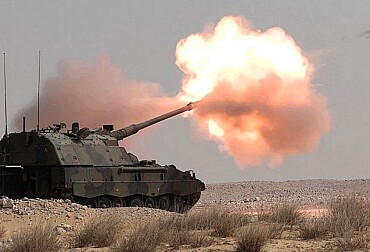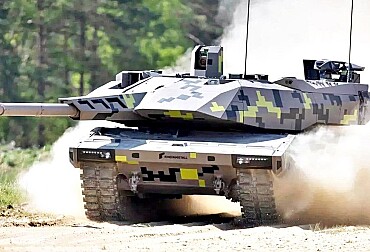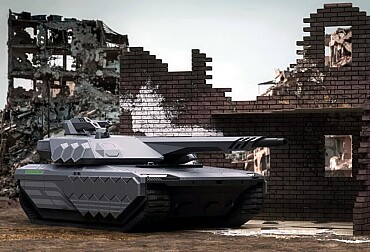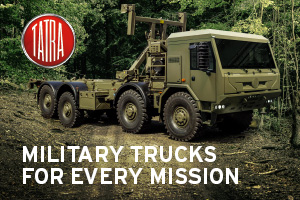Ukraine becomes the first user of the progressive RCH 155: "It is good to have Germany at our side"
The RCH 155 (Remote Controlled Howitzer 155 millimetre) is a combination of automated artillery firepower and protected wheeled mobility. Ukraine becomes its first user. The RCH 155 will significantly strengthen Ukraine's artillery. The weapon system enables firing on the move and thus rapid fire readiness. Its mobility makes the wheeled howitzer difficult to engage and gives it a long tactical range on the road.
Launched by France and the United States in January 2024, the "artillery for Ukraine" coalition is no longer in the news at the moment, except in the retrospectives of the Ministry of the Armed Forces. The same applies to the eight other capability coalitions formed within the Ukraine Defence Contact Group, which brings together 54 of Kiev's partner countries. Nevertheless, deliveries of new artillery pieces to the Ukrainian army are continuing. This was recently the case with the "Anne of Kyiv" Brigade, which joined the Donbass with eighteen additional CAESAR self-propelled howitzers.
In December 2022 Germany announced that it would be supplying Ukraine with eighteen pieces of the RCH 155 self-propelled howitzer, which had never been exported before. This was in addition to the twenty-five PzH 2000s previously taken from the Bundeswehr inventory. An order for a further thirty-six units was placed with KNDS Deutschland in the following months. That's enough to equip three artillery battalions. On 13 January, two years after Berlin's initial announcement, the first RCH-155 was officially handed over to Boris Pistorius, the German Defence Minister, who passed it on to Oleksii Makeiev, the Ukrainian ambassador to Germany.
RCH 155 (Remote Controlled Howitzer 155 millimetre)
The RCH 155 is a systematic development of the PzH 2000. It is lighter, more flexible and a long-range artillery weapon for all areas of use which provides a high level of protection for the crew. In addition to high flexibility and top mobility, the BOXER drive module of the RCH 155 provides its crew with exceptional survivability and superior protection from mines, IEDs and ballistic threats. The RCH-155 uses components from the PzH-2000 such as the ballistic fire control computer. Offering greater protection and mobility to the two gunners needed to operate it, it has a range of between 40 and 54 km, depending on the type of 155 mm shell used. With a rate of 9 rounds per minute, it can fire on the move, reducing its vulnerability to counter-battery fire.
The synthesis of the time-tested NATO-JBMoU 155mm/L52 main gun and the unmanned AGM on BOXER chassis results in a unique level of artillery effectiveness with a present range of up to 54 km through 360° azimuth and all charge and elevation ranges without requiring support. Developed and refined from joint operations, the complete autonomy of the overall system in command, navigation and fire control, as well as its system-inherent stability open up entirely new mission options (such as firing on moving targets, encampment defence, etc.). Thanks to its network-based system architecture, the RCH 155 will also be possible to implement autonomous driving and action (remote-controlled) in the future. The fire control system and ammunition matrix can support already introduced as well as future NATO ammunition types (JBMOU-compatible). These special characteristics make the RCH 155 the world’s most future-oriented barrelled artillery system, says KNDS Deutschland on its website.
Germany has delivered the first of the fifty-four RCH 155 howitzers to Ukraine
Ukraine is the first user to receive the new wheeled howitzer RCH 155. Defence Minister Pistorius took over the state-of-the-art artillery system on 13 January 2025 from the armaments company KNDS in Kassel and passed it on directly to the Ukrainian ambassador to Germany, Oleksii Makeiev.
"Today's handover of the first RCH 155 wheeled howitzer to Ukraine is visible proof of what is possible when technological excellence and common will go hand in hand", said Mr Pistorius. This delivery "confirms the unwavering German support for Kiev in its fight for independence and shows that Germany is ready to assume responsibility for security in Europe," he added. There are plans to deliver six RCH-155s to the Ukrainian army in 2025.
The Ukrainian ambassador Oleksii Makeiev expressed his appreciation of Germany's commitment and thanked the country, visibly moved: "Today is a very special day for me. Our needs are more acute than ever," he said, adding: "If we sit down at the negotiating table one day, it will be good to be covered by the powerful German weapons and to have Germany at our side." And he posted on X: "Today is a special day for me. Today, Minister Boris Pistorius handed over the first of 54 RCH 155 wheeled howitzers to Ukraine. Our need is more acute than ever. This is how allies treat each other: they close security gaps – gaps that are bleeding wounds."
In December 2022, it was suggested that it would take KNDS Deutschland 30 months to produce the first RCH 155s for the Ukrainian army. According to Die Welt, the manufacturer was waiting for a clear signal from the German Government before starting production. Since then, the Bundeswehr has announced its intention to order eighty units by 2025, and the British Army has chosen this artillery system as part of its Mobile Fires Platform programme. Finally, it has also been selected by Switzerland.
Kassel has a long history of manufacturing military vehicles. Since the 1960s, the Bundeswehr has been procuring military vehicles from the Kassel site, in particular the Leopard 1 and 2 tanks. "Here you are showing how to turn plans into reality: with precision, determination and team spirit," praised Boris Pistorius. The real treasure of the Kassel site is the people who work there. The turning point in time has become a turning point for action thanks to the employees of KNDS. The German-French KNDS group was formed in the summer of 2015 through the merger of the German company Krauss-Maffei Wegmann/KMW with the French company Nexter Systems, two of the leading European manufacturers of military land systems.








